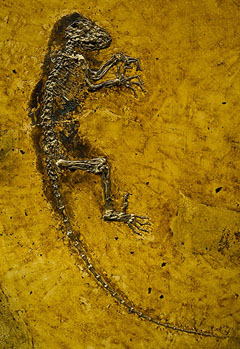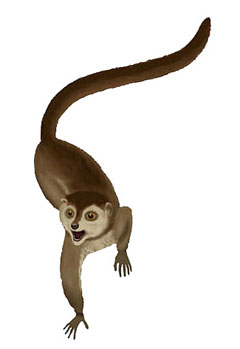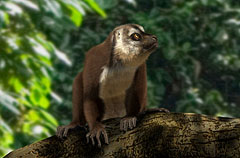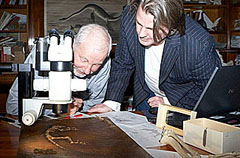Adapted excerpts from an article by professor Jens L. Franzen, The Senckenberg Museum in Frankfurt, in Natur und museum # 1 2010. See also: Who were Ida’s relatives?
We were hugely surprised when a complete primate fossil turned up at the mineral and fossil fair in Hamburg in December 2006. The fossil was even surrounded by fossilized soft tissue, preserved all the way to the tips of its hair! Only the fur of the tail was incomplete. Comparisons with the sixth primate find from Messel revealed that these two finds were each other’s counterparts.
Personally, I was made aware of the find through an e-mail from Jørn Hurum, a colleague from The Natural History Museum of The University of Oslo. I received the news about the fossil and got the opportunity to see the pictures on my 70th birthday, and I could not have wished for a better present. It was simply incredible!
 "...as the eighth wonder of the world!" |
 This is how illustrator Bogdan Bocianowski at the Natural History Museum in Oslo imagines Ida. |
The Natural History Museum in Oslo acquired the fossil. Thus it shared the fate of the first fossil of the prehistoric bird Archaeopteryx lithographica from Solnhofen, and the famous skull of the Rhine Elephant Deinotherium giganteum from Eppelsheim: Due to the price, none of these have remained near where they were found. However, it is gratifying that the fossil is now in a public collection, and that Norwegian colleagues were generous enough to invite American and German scientists to cooperate in the scientific study of it – including two researchers from The Senckenberg Museum, Jörg Habersetzer and myself.
It is a unique event, even in a world-wide context, to find such a complete fossil of a new genus and species. In honour of the 200th anniversary of Darwin’s birth, we named the genus Darwinius, and in reference to the location where it was found, the species is named masillae (in an old German area registry from around 800 AD, the Messel area is called ”Masilla”); the fossil was given the name Darwinius masillae Franzen et al. 2009.
But why had this animal received a different fate than all the other primates found in Messel up to this time? How had the skeleton and the soft tissues been so completely preserved?
Obviously, no crocodile, alligator or other amphibian predator had caused this animal’s death and its movement in the Messel lake. The fossil had no bitemarks. In what way had it died, and how did it wind up in the location where it was found?
Before we go more closely into this, let’s look at this find. It is the remains of a young female primitive primate. The sex could be determined because the fossil lacks a penis bone (baculum), as opposed to the Europolemur-skeletons from Messel (primate find 1 and 3). Since the individual was in the middle of tooth exfoliation, the age could be determined to nine or ten months.
It was the tooth exfoliation which made my Norwegian colleague Jørn Hurum think of his five-year old daughter Ida, who was at just the same stage of development. That was how the female primate from Messel received her popular-science name of ”Ida”.
Besides tooth exfoliation, the growth zones near the knuckle joints are characteristic for juveniles: They consist of cartilage. In contrast with bone- and cartilage-tissue, the decomposition of other soft tissues in the Messel lake started quickly. The bacteria involved in this process produce carbon dioxide. The water of the Messel lake contained generous amounts of iron ions from weathered granite and sandstone. These iron ions reacted with the carbon dioxide released in the decomposition processs, and formed siderite, an iron carbonate.
The siderite has been deposited as a thin yellow membrane over the layer of cartilage, which has caused it to go through a process similar to petrification. This process was shown for the first time in a doctoral thesis on the frog fauna of the Messel lake (Wuttke 1983). It has apparently also played a role in the new primate find, since the growth zones are covered in siderite deposits.
But one lump in the right wrist joint was of a very different size. Suddenly, after repeatedly studying this lump through the microscope at the museum in Oslo, scales fell from my eyes! What I was looking at did not have the pale yellow colour of the familiar siderite deposits, but was a much greyer hue. And the surface was not grainy, it was porous.
This was not siderite at all! Instead, it was bone growth, which had later been covered and strengthened by siderite. A quick look at the X-ray available on my Notebook confirmed my suspicion: The bones of the lower right arm had suffered a fracture near the wrist, and had fused with each other and with the carpal bones.
What had happened?
In all likelihood, the poor animal had fallen down from a tree and broken its right arm just above the wrist. The bones of the lower arm were pushed over the wrist, and eventually became fused with it. The little primate girl had a damaged hand!
 From the animated movie about Ida at the Senckenberg Museum. |
 Jens Franzen and Jørn H. Hurum studying Ida under the microscope. |
Jørn Hurum was also present in the room, busy with other things. I called to him: ”Jørn, come here and look at this. I think what we have here is a poorly healed arm fracture.”
Jørn came over, and after thoroughly investigating it through the microscope, he confirmed my observations. At the same time, he realized the importance of it: The damaged hand might be the reason why Ida rarely or never stayed in the trees, but mostly spent her time on the ground. There, she suffered the same fate as other mammals living on the ground – perhaps as she was drinking from the water's edge, she entered a pocket of gas, lost consciousness, fell into a small side-stream, and drowned.
At any rate, the current must have been strong enough to carry the dead body out into the Messel lake, where she quickly sank to the bottom. Not far from the river mouth, the body sank so far down that it did not decompose, but was left to fossilize undisturbed in the lack of oxygen and water currents.
In this way, she was preserved right up until today, with the almost complete skeleton and the outlines of soft tissue and stomach contents intact. Her accident was our fortune, and the fortune of anyone who is interested in paleontology and wants to know more about the life on Earth before humans.